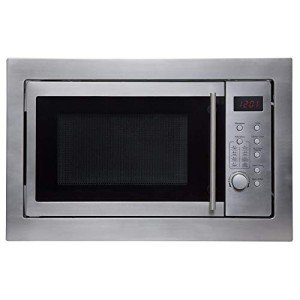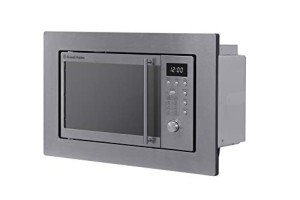See What Built In Microwave Over Oven Tricks The Celebs Are Utilizing
페이지 정보

본문
 Benefits of a Built in Microwave Over Oven
Benefits of a Built in Microwave Over OvenA built-in microwave over an oven helps you cook and reheat food quickly and conveniently. GE provides a variety of styles, cooking technology and control options that can be adapted to your kitchen.
Countertop microwaves sit on the counter and plug into an outlet or outlet, while built-in models can be installed in a recessed wall or among cabinets for an elegant, integrated look. These models require professional installation.
Space Saver
The microwave is a well-loved appliance in the kitchen, but can also occupy valuable countertop space. You can reclaim valuable counter space by moving the microwave to another space, such as an island in your kitchen.
Over-the-range microwaves (OTRs) are a popular option. This model is tucked away above your stovetop is particularly helpful in small kitchens with limited space. Some OTR models can also function as an air vent for your cooktop. This can reduce the buildup of steam.
Installing a microwave integrated into your cabinetry will help you save space. This option provides an elegant, integrated look that will match your kitchen's cabinets and fixtures in terms of color, finish or style. It can also help create a more streamlined appearance in your kitchen, which is ideal for those who prefer minimalist and clear design.
Installing a built-in microwave could require a professional installation or a kitchen remodel. You might be able to, based on the layout of your house to make an opening in the wall to install the appliance. However, this will require professional framing and strengthening. Built-in microwaves also require adequate ventilation to avoid overheating or damaging the appliance. According to Sam Cipiti, vice president of R. M. Tunis Kitchens and Baths in Chevy Chase, Maryland, the minimum cabinet microwave built in depth for a microwave built-in is around 15 inches, but some manufacturers provide trim kits that can provide up to 1 1/2 inches of additional space for ventilation.
A third option to reduce space is a drawer-style microwave which can be set up under your counter or inside an island. This design is easily accessible, suitable for all ages and requires less counter space. It also helps prevent hot dishes or containers falling off the edge or being knocked down.
The final aspect to consider for the space-saving microwave is the door design. Many manufacturers offer the option of a swing-out, drop-down, or slide-out door that opens using the same motion as other kitchen appliances to allow you to seamlessly integrate your microwave into your cooking routine. Some models have a smooth, sleek exterior that is resistant to finger prints for better and cleaner appearance.
Convenience
Built-in microwaves that are built into ovens are attractive, convenient, and easy to clean. Contrary to countertop models, they're typically placed at the eye level for easy access and can be equipped with turntables that reduce the need to constantly shift food from plate to plate. Built-in microwaves are usually equipped with features that enhance their functionality, such as EasyConvection technology to convert ovens and a broiler that can cook or brown food.
A built-in microwave that is integrated into the oven can help you save counter space, and can also boost the value of your home by giving it a sleek, high-end appearance that other appliances might not be able to match. The microwaves can be placed above the stove, or in a separate cupboard. They seamlessly blend into the kitchen, giving the appearance of a custom-designed appearance that shows how much you have invested in your home and kitchen.
best built in combi microwave-in microwaves and ovens are available in various sizes, power levels, and features that can be customized to suit any kitchen. They can be placed under your counter in a drawer style to give a more cohesive look that fits snugly into your cabinetry and requires no additional space. These microwaves, with their premium features and finishes, will enhance the aesthetics of your kitchen and enhance your dining and cooking experiences.
While the benefits of a built-in microwave over oven is obvious, keep in mind that these microwaves aren't as versatile as their freestanding counterparts. Depending on the place you install yours, it may require more space to operate than other microwaves. They are also not as portable, and you can't easily change the model if you need something else.
If you decide to put your microwave over your range, then you'll need a larger space in your kitchen to allow for the ventilation required in this setup. You'll need either an ducting system that sends smoke away from the home or a recirculating system that draws air through the microwave before transferring it to the home. If you have a smaller kitchen, consider a separate microwave built-in which can be fitted in cabinets, walls or an island.
Convenient Controls
Microwave ovens are equipped with numerous controls depending on the model you choose. Some of the features include turntables, presets for defrosting or reheating, and buttons that can last for up to 30 minutes. Some models have child safety features to avoid accidental operation.
Many microwaves come with pre-programmed recipes and cooking times, which makes the process of cooking food quicker and more efficient. This feature is beneficial for new cooks that are not sure of the time needed to cook specific food items or are not familiar with the cooking techniques employed in various cuisines.
KitchenAid brand offers a wide selection of built-in and over the-range microwaves that are designed to match the style and appearance of other appliances for an aesthetically pleasing kitchen. You can find a selection of stainless steel integrated microwave steel models, as well as black and white finishes to complement any kitchen design. These premium microwaves are boldly designed to bring professional-inspired styles into your home, and they're made with high-quality materials for a longer lifespan.
Built-in microwaves, unlike countertop models, are installed in a fixed area of your kitchen cabinets or walls to give a sleek and custom look. They typically use the same components inside as regular countertop models, but with some exceptions. These models come in a variety of sizes, including those designed to fit in a compact space and their exteriors could feature a door that opens either in a left-to right swing-out or drop-down style.
Some microwaves over the range, such as those made by Whirlpool(r), can also be used as vent hoods. They come with an exhaust system that is built-in to vent fumes outdoors and then recirculate the air. Others have a built-in charcoal filter to remove odors and moisture from your kitchen.
Countertop models are placed on your kitchen counter and do not require venting hookups, or any special installation, making them a great option for rental properties or those who want to avoid costly modifications to their kitchens. Certain models include trim kits that can close the gap between your microwave and other countertop appliances such as coffee makers and bread makers, as well as toaster ovens.
Energy Efficiency
Microwaves consume less energy to heat food and water than other cooking methods. They also use less power than conventional stovetops because the microwaves focus their energy on the liquid in instead of heating the air around it. Because of this, they can cook food more quickly than conventional ovens. They can be put in your lower or upper cabinets, and come with retro or contemporary styles to suit any kitchen design.
In this supplemental notice of proposed rulemaking ("SNOPR") the Office of Energy Efficiency and Renewable Energy proposes new or modified energy conservation standards for microwave ovens, which will save consumers money on operating costs. The Energy Policy and Conservation Act ("EPCA") requires DOE to evaluate on a regular basis whether stricter standards are economically viable and technologically feasible, as well as result in significant energy savings.
The SNOPR contains DOE's analyses and results to assess the impact of the new or modified energy standards for microwave ovens on the consumer. The analysis includes a market and technology assessment and screening analysis of engineering analysis, and a national impacts analysis.
The energy use analysis estimates annual average microwave oven operating hours in representative sampled homes. This analysis is used to calculate energy savings as well as other consumer analyses within this SNOPR. The analysis is made using RECS field data from various regions, and takes into account the various patterns of use of microwave ovens in different households, as well as the variation in the regional electricity prices.
In order to assess the impact of the new or modified standards on household costs, DOE conducted LCC analyses and PBP analyses in order to estimate the cost over time for purchasing and using a micro-wave oven at various levels of efficiency. The LCC and PBP calculations employ the computer model that is based on Monte Carlo simulations to incorporate uncertainty and variation into the analyses.
 This SNOPR includes an assessment of the impact of the new or amended standards at the national scale based on the NIA spreadsheet. The NIA model determines industry net present value ("INPV") in terms of energy savings from the potential amendment or new standards in terms of energy savings at the site and FFC energy savings.
This SNOPR includes an assessment of the impact of the new or amended standards at the national scale based on the NIA spreadsheet. The NIA model determines industry net present value ("INPV") in terms of energy savings from the potential amendment or new standards in terms of energy savings at the site and FFC energy savings.- 이전글5 Killer Quora Answers To Private ADHD Assessment London 24.11.24
- 다음글7 Days To A Better Online Poker Sites 24.11.24
댓글목록
등록된 댓글이 없습니다.
